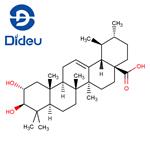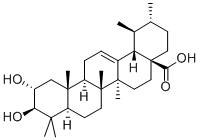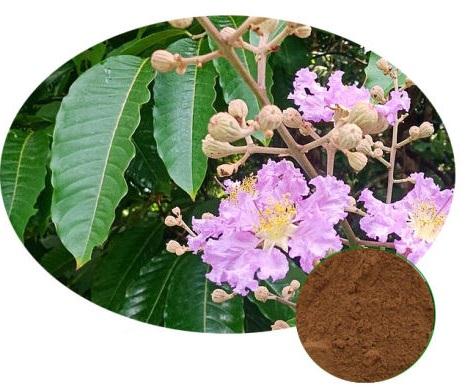Corosolic Acid: Antidiabetic Effects & Structural Analogs
Corosolic acid is a natural compound with various biological activities, such as antidiabetic, anti-inflammatory, and anticancer. There are two possible mechanisms of action for it. The first is that it may improve the sensitivity of the insulin receptor on all cells of the body. Insulin has to bind to this receptor to allow blood glucose to enter the cells of your body. If it does not bind to the receptor, this results in increased levels of insulin in your blood, which can damage the nerves, brain, eyes, and any other part of the body that is vulnerable to insulin damage. Corosolic acid improves the sensitivity of the insulin receptor by inhibiting a protein in the body called tyrosine phosphatase, which reduces insulin receptor site activity. Corosolic acid is a naturally occurring compound that has been used safely as a primitive herb, and now as a supplement. It has a very good safety profile, with no known side effects other than a possible allergic reaction. If you are a metabolic syndrome or pre-diabetes sufferer, it can be useful to enhance your health.

Biological effects of corosolic acid as an anti-inflammatory
Cancer is one of the most common causes of mortality worldwide. However, it is not only a serious threat to public health, but also a global socioeconomic burden. An estimated 2,814,000 cases of cancer-related death and 4,292,000 new cancer cases occurred in China in 2015. Based on GLOBOCAN (a global cancer statistics database), in 2018 the number of cases of cancer-related death was 9.6 million, and the number of new cancer cases was 18.1 million worldwide. Corosolic acid is known as a ‘phyto-insulin’ or ‘botanical insulin’. It is the principal component of Lagerstroemia speciosa leaves (also called Banaba), a tropical plant found in the Philippines, Vietnam, Malaysia and Southern China. Experimental studies have indicated that corosolic acid plays a pivotal anticancer role in several tumorigenic processes in vitro and in vivo, including cellular proliferation, apoptosis, angiogenesis, lymphangiogenesis, metastasis and tumor immunity, and it exerts a synergistic effect when administered with other anticancer agents. In addition, corosolic acid has the ability to modulate multiple cancer-related signaling pathways and processes, such as the nuclear factor kappa-B (NF-κB), phosphatidylinositol 3 kinase/protein kinase B (PI3K/Akt) and Wnt/β-catenin pathways, apoptosis, nuclear factor erythroid 2-related factor 2 (Nrf2) and several other components associated with cellular proliferation or mortality.[1]
Animal and human studies and in vitro systems have indicated that corosolic acid has multiple properties, including anti-diabetic, anti-obesity, anti-inflammatory, anti-hyperlipidemic and anti-viral activity. On the other hand, as aforementioned, it has shown an ability to modulate multiple cancer-related signaling pathways, including the adenosine mitogen-activated protein kinase (AMPK), NF-κB, PI3K/Akt/mTOR, Wnt/β-catenin, FAK, ERK1/2, STAT3 in MDSCs, Nrf2/HO-1 and numerous other signaling pathways associated with cell proliferation and cell death, among other cellular processes in multiple types of malignant tumors (as observed in preclinical in vitro and in vivo experiments). The present review summarizes current advancements in our understanding of the anticancer activity and mechanisms of corosolic acid in vitro and in vivo. Due to the ability of this acid to target multiple components of cancer cells, it acts not only as an anticancer agent but also as a synergistic adjuvant when administered alongside chemotherapeutic drugs, even in drug-resistant cells. In addition, parts of the same mechanism that ameliorates MS also induces anticancer activity and suppresses the progression of NAFLD-related HCC. Therefore, corosolic acid, a potential tool in MS treatment, is being considered as a possible agent in NAFLD-related HCC prevention and treatment.
Corosolic acid and its structural analogs
Corosolic acid (CA), an ursane-type pentacyclic triterpenoid, is extracted from a variety of plants such as banaba, Japanese loquat leaves, and so on. CA could exist in plants freely or in the form of saponins. It is often co-existed with the isomer of MA, which had similar structure and chemical properties. CA and MA are derivatives of UA and OA, respectively. CA has many structural analogs including UA, OA, MA, AA and BA, all of which are extracted from plants and have similar pharmacological effects to CA. CA acts as insulin on glucose metabolism, hence it also called plant insulin in treating diabetes mellitus, a group of metabolic disorders caused by absolute or relative insufficient secretion of insulin/or insulin utilization. Diabetes is mainly marked by high blood sugar, which can lead to insomnia, blindness, amputation of limbs, stroke, cardiovascular diseases and cancer. The oral hypoglycemic agents include synthetic small molecule drugs such as metformin, pioglitazone, glimepiride and acarbose etc, which act through different mechanisms while injectable agents are represented by insulin, an antidiabetic protein drug. Many studies were reported to have modified the structure of Corosolic acid and its structural analogs, such as the introduction of water-soluble sugar group, amino group and other structures, and designed formulations to improve its solubility and bioavailability.[2]
The pharmacokinetic process of Corosolic acid and its structural analogs were studies in rats. The results showed that the bioavailability of AA was 16.25%, and oral absorption was better than CA (0.93%), UA (8.72%) and OA (0.7%), respectively, possibly because the C23 position of AA was substituted by hydroxyl group, which led to an increase in solubility. Their rigid skeleton and hydrophobic backbone make it poorly water-soluble and low in bioavailability. Structural modification and formulation design to increase drug solubility played an important role in improving the bioavailability. The SMEDDS, liposomes and nanoparticles and so on were indispensable methods to increase the dissolution of drugs, by which could improve the oral absorption and bioavailability. CA and its structural analogs have similar effects, such as hypoglycemic, anti-inflammatory and anti-tumor effects. Corosolic acid and its structural analogs all exhibited the hypoglycemic effect by inhibiting α-glucosidase and increasing cellular uptake of glucose. Moreover, UA andAA transported glucose through GLUT4, promoted insulin secretion and improved insulin resistance. The mechanism of action is the same in reducing blood sugar, but different in anti-inflammatory. Studies have found that Corosolic acid ameliorated inflammation by suppressing phosphorylation and transcription of IRAK-1 or suppressing NLRP3 inflammasome activation.
Diabetes Complications with Banaba (Lagerstroemia speciosa L.) and Corosolic Acid
Banaba (Lagerstroemia speciosa L.) has been used as a folk medicine to treat diabetes in various parts of the world, primarily southeast Asia. Banaba extracts have been used for many years in folk medicine to treat diabetes, with the first published research study being reported in 1940. This paper summarizes the current literature regarding Banaba and its constituents. The hypoglycemic effects of Banaba have been attributed to both corosolic acid as well as ellagitannins. Studies have been conducted in various animal models, human subjects, and in vitro systems using water soluble Banaba leaf extracts, corosolic acid, and ellagitannins. Corosolic acid has been reported to decrease blood sugar levels within 60 min in human subjects. It also exhibits antihyperlipidemic and antioxidant activities. The beneficial effects of Banaba and corosolic acid with respect to various aspects of glucose and lipid metabolism appear to involve multiple mechanisms, including enhanced cellular uptake of glucose, impaired hydrolysis of sucrose and starches, decreased gluconeogenesis, and the regulation of lipid metabolism. These effects may be mediated by PPAR and other signal transduction factors. Banaba extract, corosolic acid, and other constituents may be beneficial in addressing the symptoms associated with metabolic syndrome, as well as offering other health benefits.[3]
References
[1]Zhao J, Zhou H, An Y, Shen K, Yu L. Biological effects of corosolic acid as an anti-inflammatory, anti-metabolic syndrome and anti-neoplasic natural compound. Oncol Lett. 2021 Feb;21(2):84. doi: 10.3892/ol.2020.12345. Epub 2020 Dec 2. PMID: 33363621; PMCID: PMC7723172.
[2]Qian, Xu-Ping et al. “Corosolic acid and its structural analogs: A systematic review of their biological activities and underlying mechanism of action.” Phytomedicine : international journal of phytotherapy and phytopharmacology vol. 91 (2021): 153696. doi:10.1016/j.phymed.2021.153696
[3]Miura T, Takagi S, Ishida T. Management of Diabetes and Its Complications with Banaba (Lagerstroemia speciosa L.) and Corosolic Acid. Evid Based Complement Alternat Med. 2012;2012:871495. doi: 10.1155/2012/871495. Epub 2012 Oct 2. PMID: 23082086; PMCID: PMC3468018.
Related articles And Qustion
Lastest Price from Corosolic acid manufacturers

US $0.00/kg2025-06-11
- CAS:
- 4547-24-4
- Min. Order:
- 1kg
- Purity:
- 98%
- Supply Ability:
- 1000kg

US $0.00/kg2025-04-29
- CAS:
- 4547-24-4
- Min. Order:
- 1kg
- Purity:
- 0.99
- Supply Ability:
- 1000kg



